
#USING IBM SPSS STATISTICS HOW TO#
Students will gain an understanding of when and why to use these various techniques and how to apply them with confidence, interpret their output, and graphically display the results. This includes a broad range of techniques for exploring and summarizing data, as well as investigating and testing relationships.

Students will review several statistical techniques and discuss situations in which they would use each technique, how to set up the analysis, and how to interpret the results.

He is also program director at the Centre for Workplace Leadership, a fellow at the EU centre for shared complex challenges, as well as a fellow at the Centre for Business Analytics at Melbourne Business School.This course provides an application-oriented introduction to the statistical component of IBM SPSS Statistics. His research has been published in journals such as Journal of Marketing, the Journal of Marketing Research, the International Journal of Research in Marketing, and the Journal of Business Research. His main interest is in business-to-business marketing and works on topics such as outsourcing, inter-firm contracting, innovation, technology licensing, and franchising using advanced econometrics. Ringle).Įrik Mooi is senior lecturer at the University of Melbourne (Australia). Marko has co-edited several special issues of leading journals and co-authored several widely adopted textbooks, including “A Primer on Partial Least Squares Structural Equation Modeling (PLS-SEM)” (together with Joe F. His research has been published in journals such as Journal of Marketing Research, Journal of the Academy of Marketing Science, Organizational Research Methods, MIS Quarterly, and International Journal of Research in Marketing. His main research is in the application and advancement of structural equation modeling methods to further the understanding of consumer behavior and to improve marketing decision-making. Marko Sarstedt is chaired professor of Marketing at the Otto-von-Guericke-University Magdeburg (Germany).
#USING IBM SPSS STATISTICS SOFTWARE#
A glossary that includes definitions of all the keywords and other descriptions of selected topics Using IBM SPSS Statistics for Research Methods and Social Science Statistics is the perfect companion for students who are learning to use SPSS software to interpret and manage data within their social statistics and/or research methods courses.Improved use of educational elements, such as learning objectives, keywords, self-assessment tests, case studies, and much more.New material on survey design and all data analysis methods to reflect the latest advances concerning each topic.A single case and dataset used throughout the book to facilitate learning.The new edition uses IBM SPSS version 25 and offers the following new features: Highly engaging and hands-on, the book includes many practical examples, tips, and suggestions that help readers apply and interpret the data analysis methods discussed. Hypothesis tests, ANOVA, regression analysis, principal component analysis, factor analysis, and cluster analysis, as well as essential descriptive statistics, are covered in detail. The book helps readers perform analyses, interpret the results, and make sound statistical decisions using IBM SPSS Statistics. Note Before using this information and the product it supports, read the information in Notices on page 93. This tutorial shows how to run and interpret it in SPSS. The SW-test is an alternative for the Kolmogorov-Smirnov test. This assumption is required by some statistical tests such as t-tests and ANOVA. The Shapiro-Wilk test examines if a variable is normally distributed in a population. It is intended for all readers who wish to know more about the market research process, data management, and the most commonly used methods in market research. SPSS Shapiro-Wilk Test Quick Tutorial with Example. This book offers an easily accessible and comprehensive guide to the entire market research process, from asking market research questions to collecting and analyzing data by means of quantitative methods.


 0 kommentar(er)
0 kommentar(er)
